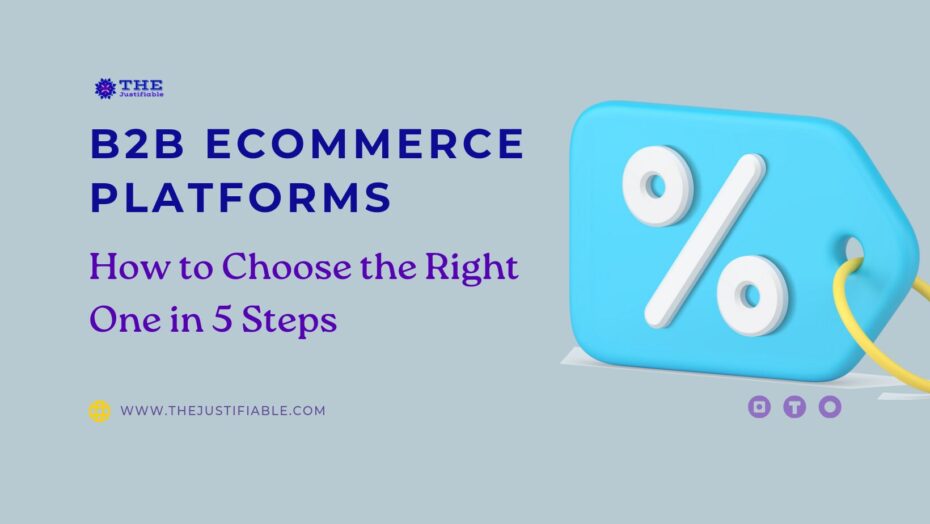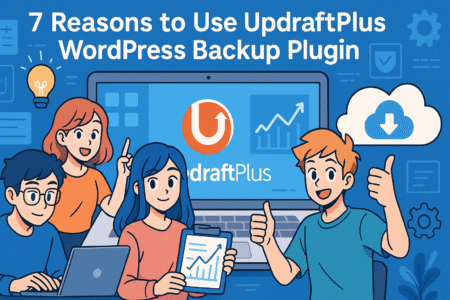Table of Contents
Choosing the right B2B ecommerce platform is the cornerstone of your business’s online success. Your choice doesn’t just represent a piece of technology; it’s a pivotal decision that will shape your business’s future, customer relationships, and growth trajectory.
As you embark on this journey, it’s crucial to recognize the unique challenges and opportunities that come with selecting a platform tailored to the complex and evolving needs of B2B transactions.
Understanding the significance of this decision is just the beginning. The landscape of B2B ecommerce platforms is vast and varied, each offering a plethora of features and capabilities. But fear not, as this guide is crafted to empower you with knowledge and insights, making your decision-making process as informed and straightforward as possible.
In the following sections, we’ll guide you through the essential steps to evaluate and choose a B2B ecommerce platform that not just meets, but exceeds, your expectations.
Step 1: Assessing Your Business Needs
When you begin your journey to select the perfect B2B ecommerce platform, the first and foremost step is to thoroughly assess your business needs.
This initial step is critical in ensuring that the platform you choose not only fits your current requirements but also has the capacity to evolve with your business.
Identifying Key Features for Your B2B Ecommerce Platform
Identifying the key features that your B2B ecommerce platform must have is akin to laying the foundation for a building. It’s about understanding the core functionalities that will drive your online business. Start by evaluating the nature of your products or services.
Ask yourself, what specific features will best showcase my offerings? This could range from customizable product catalogs to advanced pricing and discount management that caters to diverse customer segments.
Next, consider the user experience. In the B2B sector, where transactions are often more complex than in B2C, a seamless, intuitive user interface is crucial. Your platform should simplify the buying process for your clients, making it easy for them to find products, place orders, and manage their accounts. Think about features like quick order forms, re-order capabilities, and multi-level customer approvals.
Another vital feature to look for is integration capability. Your B2B ecommerce platform should seamlessly integrate with your existing CRM, ERP, and accounting systems. This integration is key to maintaining data consistency, improving operational efficiency, and providing a unified view of your business.
Understanding Your Customer and Market Requirements
Understanding your customers’ and market’s unique requirements is essential in choosing a B2B ecommerce platform. This understanding goes beyond knowing their basic needs; it’s about delving into how they interact with your platform and what features will enhance their buying experience.
Consider conducting a survey or interviews with your key customers to understand their pain points and preferences. What features do they find most useful? What challenges do they face with your current system? This feedback is invaluable in tailoring your platform to meet their specific needs.
Also, keep in mind the broader market trends and requirements. Stay informed about the latest developments in B2B ecommerce, such as mobile optimization, AI-driven personalization, and advanced analytics. These trends can offer insights into features that may become essential in the near future, ensuring that your platform remains competitive and cutting-edge.
Step 2: Evaluating B2B Ecommerce Platform Options
Embarking on the journey of evaluating B2B ecommerce platform options is a pivotal step in your digital strategy. This stage is not just about comparing different platforms, but about finding a solution that aligns perfectly with your business’s unique requirements and future goals.
Comparing Core Functionalities and Scalability
When comparing the core functionalities of various B2B ecommerce platforms, focus on how well they align with your identified business needs. Key functionalities might include advanced order management, customizable pricing structures, and robust catalog management. Consider how these platforms handle complex B2B transactions, like bulk orders, tiered pricing, and long-term contracts.
Scalability is another critical factor in your evaluation. As your business grows, you’ll need a B2B ecommerce platform that can grow with you, adapting to increased traffic, expanding product lines, and evolving customer needs. Look for platforms that offer flexibility in terms of adding new features, integrating with other systems, and scaling up operations without significant downtime or cost increases.
Analyze how each platform’s features can streamline your operations, improve customer experience, and ultimately contribute to your business’s success. Remember, the right platform should offer a balance between comprehensive functionality and the flexibility to adapt to future challenges and opportunities.
Security and Compliance Considerations in B2B Ecommerce
In today’s digital landscape, security and compliance are paramount, especially in the B2B sector where transactions often involve sensitive business information. Evaluate the security measures of each B2B ecommerce platform. Look for features like data encryption, secure payment processing, and robust user authentication protocols.
Compliance is equally important. Ensure that the platforms you’re considering comply with relevant industry standards and regulations, such as GDPR for European customers or PCI DSS for payment processing. Compliance is not just about avoiding penalties; it’s about building trust with your customers by safeguarding their data and privacy.
Additionally, consider the platform’s track record and reputation regarding security and compliance. Research any past security breaches or compliance issues. A platform’s history can give you valuable insights into their commitment to security and compliance, and how they handle potential vulnerabilities.
Step 3: Analyzing Integration Capabilities
In the journey of selecting the right B2B ecommerce platform, analyzing the integration capabilities of each option is a crucial step.
This analysis is more than a technical evaluation; it’s about ensuring that your chosen platform can harmoniously blend with your current business ecosystem, enhancing efficiency and productivity.
Ensuring Seamless Integration with Existing Systems
Seamless integration with existing systems is vital for a smooth transition to your new B2B ecommerce platform. This integration affects various aspects of your business, from inventory management to customer relationship management (CRM) and accounting systems.
The right platform should be able to integrate effortlessly with your current software, avoiding any disruption in your day-to-day operations.
When evaluating integration capabilities, consider the extent to which the platform can connect with your existing databases and software. Does it allow for real-time data syncing? Can it seamlessly transfer customer information, product data, and order details between systems?
These are critical questions that need affirmative answers to ensure you are choosing a platform that enhances, rather than impedes, your operational efficiency.
Furthermore, think about the long-term implications of integration. As your business evolves, your software needs might change. The B2B ecommerce platform you select should be flexible enough to integrate with new tools and technologies as they become relevant to your business.
The Role of API Support in B2B Ecommerce Platforms
API (Application Programming Interface) support is a cornerstone of modern B2B ecommerce platforms. APIs play a pivotal role in enabling the integration of various software systems, allowing them to communicate and work together effectively.
A robust API can be the difference between a platform that fits seamlessly into your business and one that requires constant manual intervention.
When assessing a platform’s API capabilities, consider both the breadth and depth of the APIs offered. Are they well-documented and developer-friendly? Can they support custom integrations tailored to your specific business processes?
The ability to customize integrations through APIs offers a level of flexibility that can significantly benefit your business.
Additionally, evaluate the support provided for these APIs. Good customer support and regular updates are indicators of a platform committed to maintaining strong API capabilities. This commitment is essential for ensuring long-term compatibility and functionality as technology evolves.
Step 4: Considering Costs and Return on Investment
Navigating the financial aspects of choosing a B2B ecommerce platform is a critical step in your decision-making process.
This step goes beyond just looking at the initial price tag; it involves a comprehensive understanding of the platform’s pricing models and how they align with your business’s return on investment (ROI) goals.
Understanding Pricing Models of B2B Ecommerce Platforms
Each B2B ecommerce platform comes with its unique pricing model, and understanding these models is key to making an informed decision. Some platforms may offer a flat monthly or annual fee, while others might charge based on the number of users, transactions, or revenue generated.
It’s important to closely examine what is included in these fees. Are there additional costs for essential features, customer support, or updates?
Also, consider the scalability of the pricing model. As your business grows, will the costs associated with the platform scale in a way that is sustainable for your business? A platform that seems cost-effective for a small operation might become prohibitively expensive as your transaction volumes and user base grow.
Understanding the pricing structure will help you anticipate not just the initial costs but also the ongoing expenses of operating the platform, ensuring that there are no hidden surprises down the line.
Calculating Long-term ROI and Total Cost of Ownership
When evaluating B2B ecommerce platforms, it’s crucial to look beyond the immediate costs and consider the long-term return on investment and total cost of ownership (TCO).
This calculation should factor in not only the direct costs associated with the platform but also the indirect costs, such as the time and resources required for implementation, training, and maintenance.
Consider how the platform will contribute to increasing efficiency, improving customer satisfaction, and driving sales. A platform that offers robust analytics, for instance, might carry a higher price tag but could provide valuable insights that help you optimize your sales strategy and improve your bottom line.
Additionally, think about the potential for the platform to reduce costs in other areas. For instance, a platform that automates order processing and inventory management can lead to significant savings in labor and reduce the likelihood of errors.
Step 5: Gathering Feedback and Testing
As you approach the final stages of selecting a B2B ecommerce platform, gathering feedback and conducting thorough testing emerge as pivotal steps.
This phase is not just about validation; it’s an opportunity to ensure that your chosen platform truly resonates with the needs of your customers and stands up to the demands of your industry.
Leveraging Customer and Industry Feedback
Engaging with your customer base and industry peers to gather feedback is invaluable in making a well-informed decision. Your customers, the end-users of the platform, can provide insights that might not be immediately apparent.
Reach out to them through surveys, interviews, or focus groups to understand their experiences, preferences, and pain points.
Similarly, industry feedback, especially from peers who have already navigated the process of selecting a B2B ecommerce platform, can be enlightening. Industry forums, trade shows, and professional networks are excellent sources for this type of feedback.
They can offer real-world insights into how different platforms perform under various business scenarios.
This feedback will not only guide you in choosing a platform that meets the market’s needs but also one that has the potential to enhance your business’s reputation and customer satisfaction.
Importance of Demo or Trial Periods in Decision Making
Demo or trial periods are critical components of the decision-making process. They offer a hands-on experience with the platform, allowing you to test its functionalities, user interface, and integration capabilities in a real-world setting.
During a demo or trial, pay close attention to how intuitive and user-friendly the platform is. Can your team navigate it easily? Does it simplify or complicate your existing processes?
Use this period to test how well the platform integrates with your current systems. Check for any compatibility issues and assess the ease of transferring data. This is also the time to evaluate the platform’s performance under various scenarios, such as high traffic volumes or complex transaction processes.
A demo or trial period is not just a test for the platform but also a litmus test for the vendor’s support and service. How responsive and helpful are they during this phase? This can be indicative of the level of support you can expect once you’ve committed to the platform.
Conclusion: Making Your Final Decision
As we reach the conclusion of our guide on how to choose the right B2B ecommerce platform, it’s time to reflect on the journey you’ve undertaken. This final section is designed to help you consolidate your findings and make a decision that will significantly impact the future trajectory of your business in the digital marketplace.
Choosing the right B2B ecommerce platform is not just a technical decision; it’s a strategic move that will influence your business’s operational efficiency, customer relationships, and growth potential.
You’ve assessed your business needs, compared platform functionalities, considered costs and potential ROI, analyzed integration capabilities, and gathered valuable feedback. Now, it’s about bringing all these elements together to make a well-informed, confident decision.
As you stand at this crossroads, consider not only the immediate benefits of the platform but also its long-term potential. How well does it align with your future business goals? Can it adapt to the ever-changing digital landscape and the evolving needs of your customers?
The right platform is one that not only meets your current requirements but also supports your growth and evolves with your business.
Remember, the decision you make today will shape your business’s future. It’s not just about selecting a software solution; it’s about choosing a partner in your digital transformation journey.
A partner that will support your business objectives, enhance your operational capabilities, and help you deliver exceptional value to your customers.






